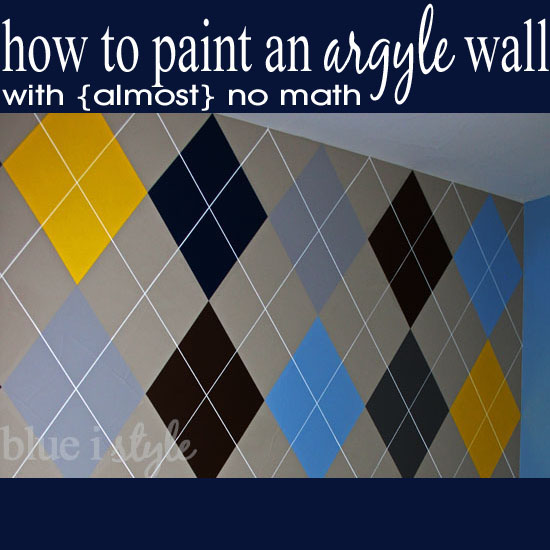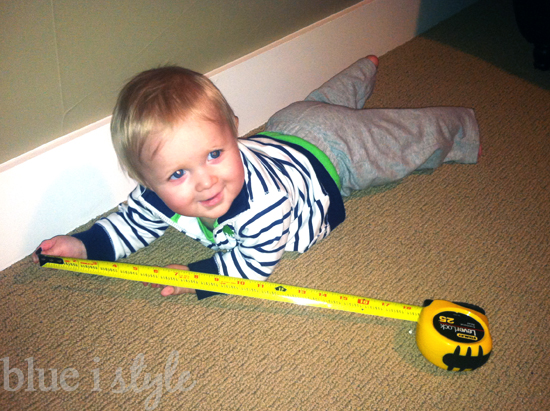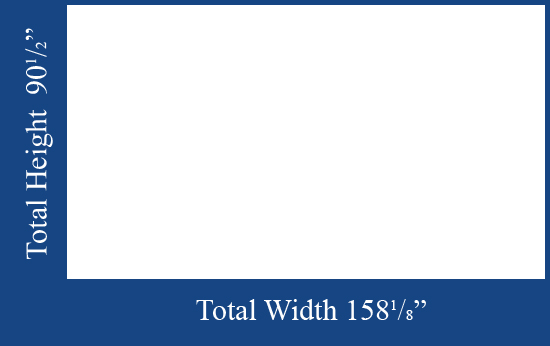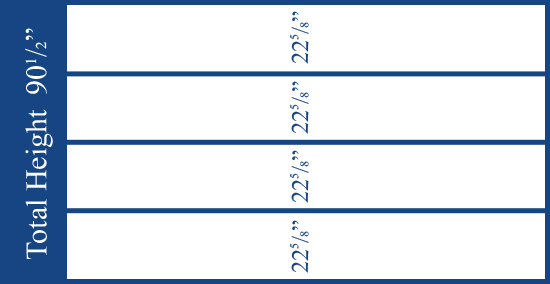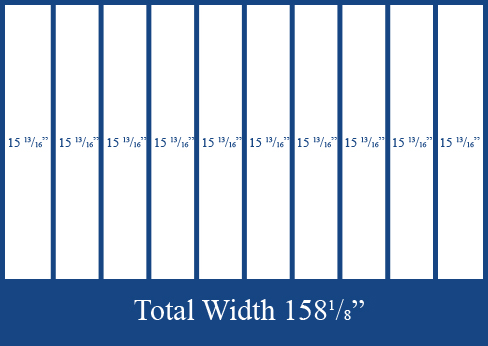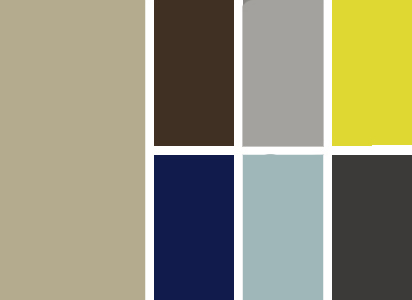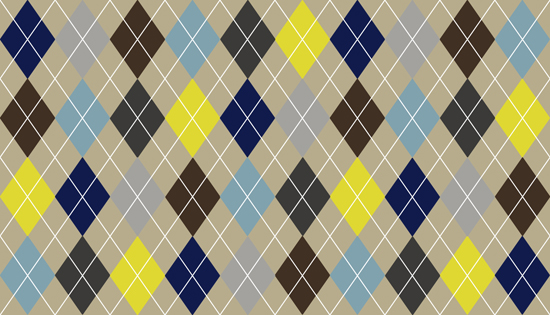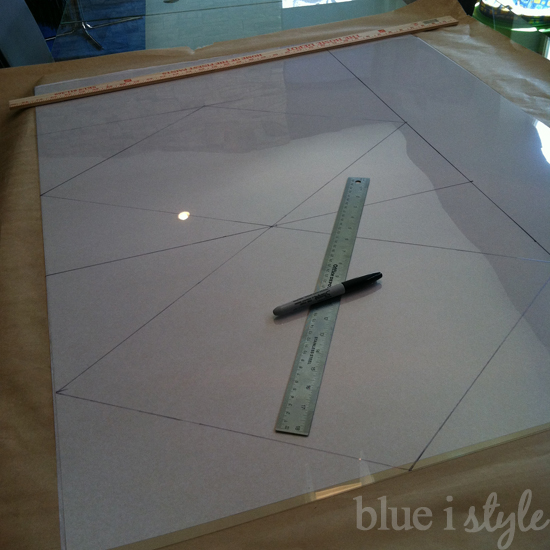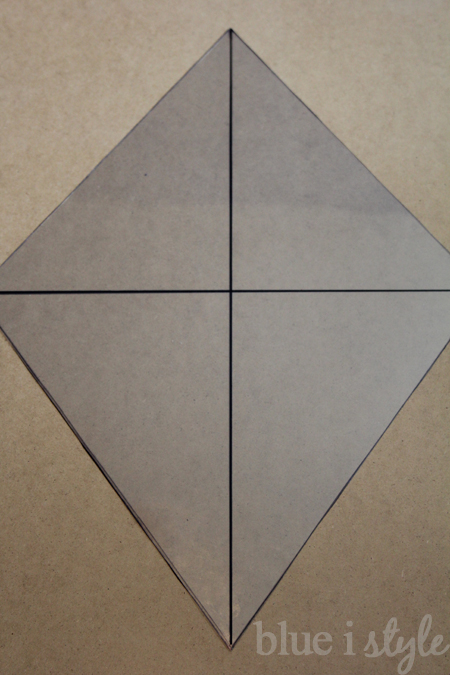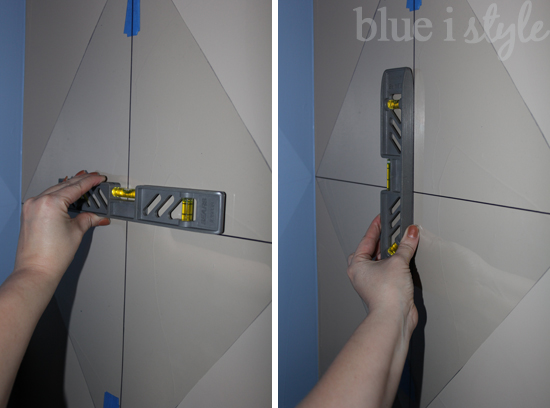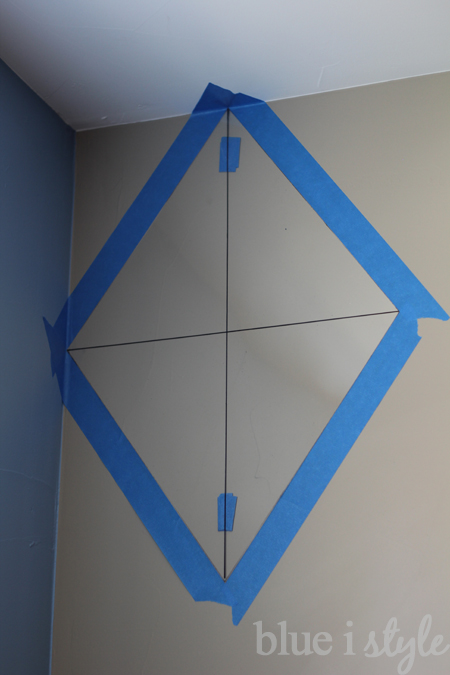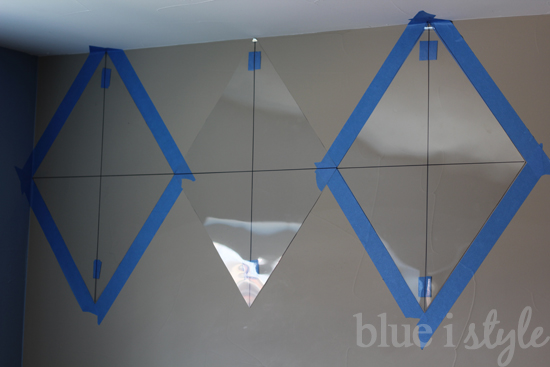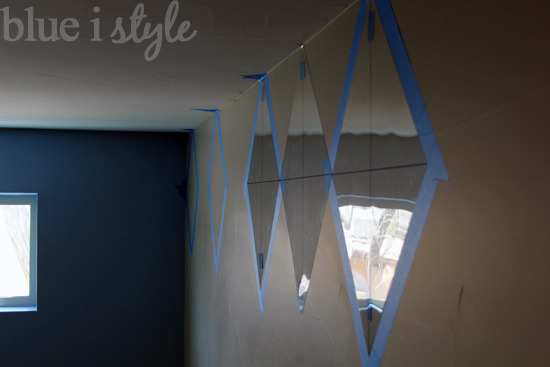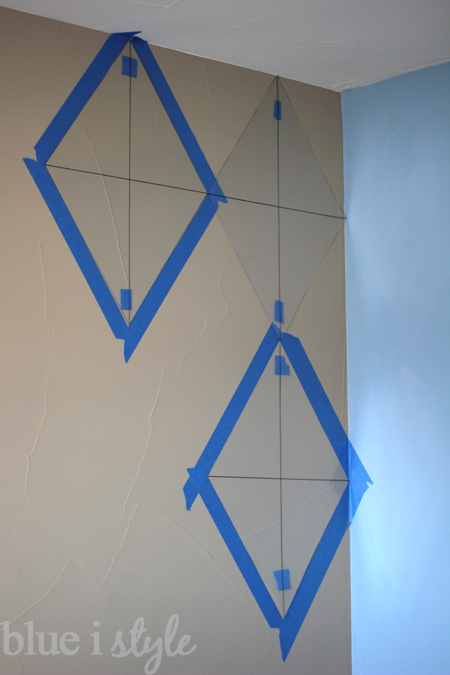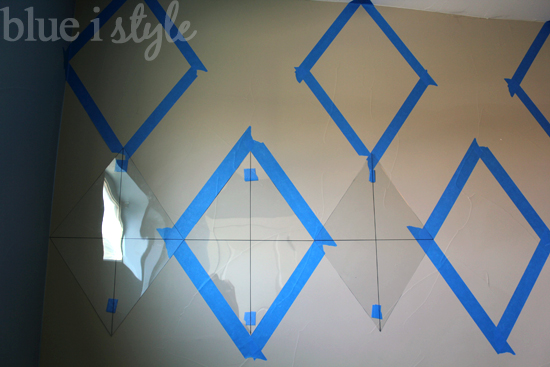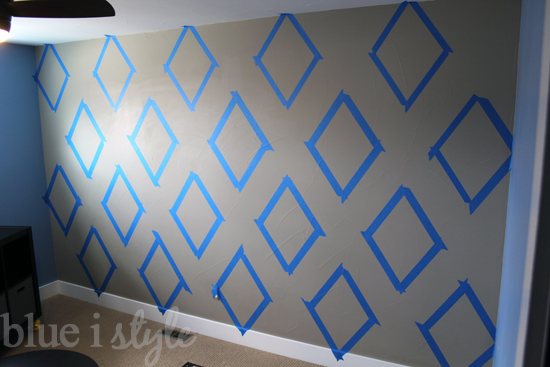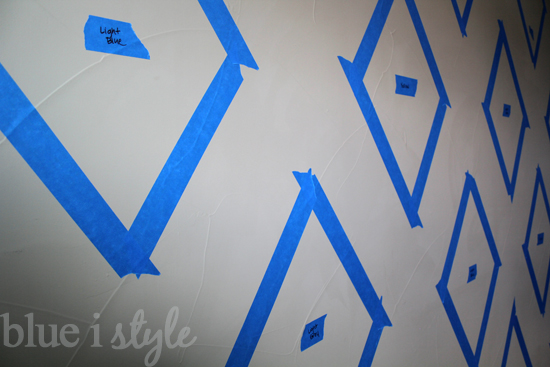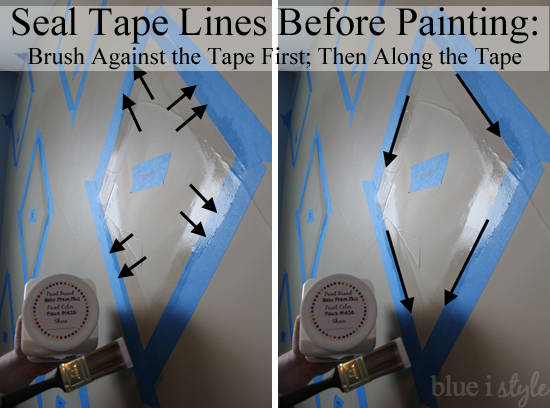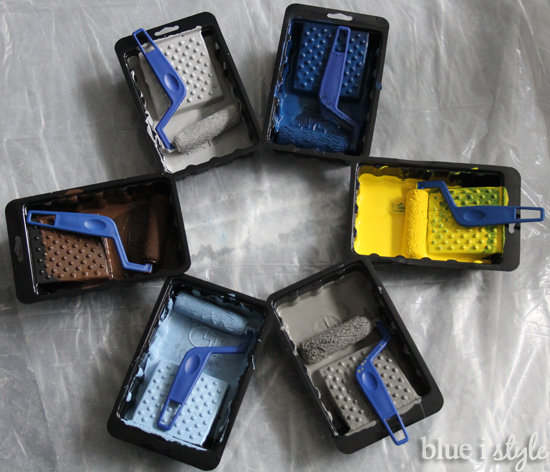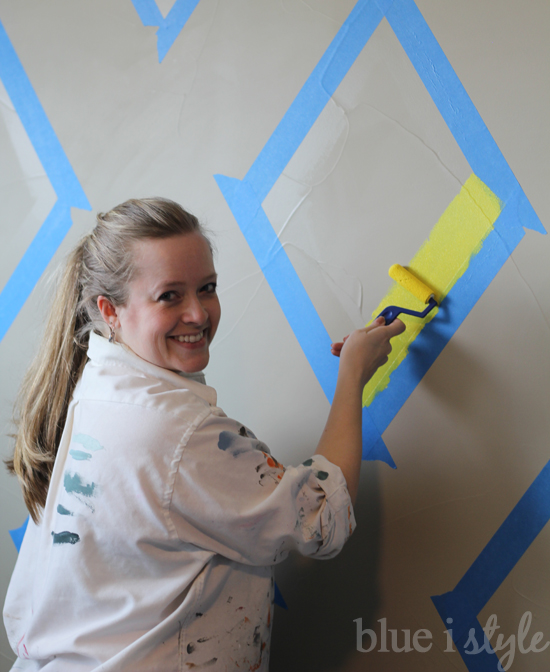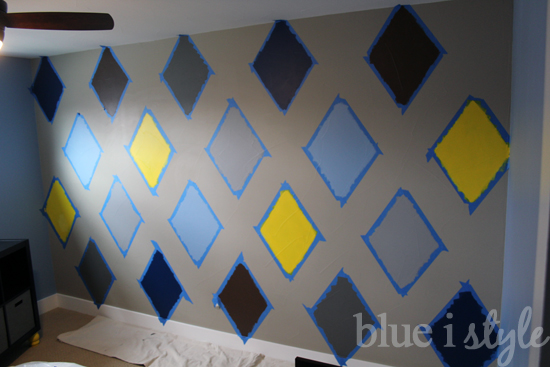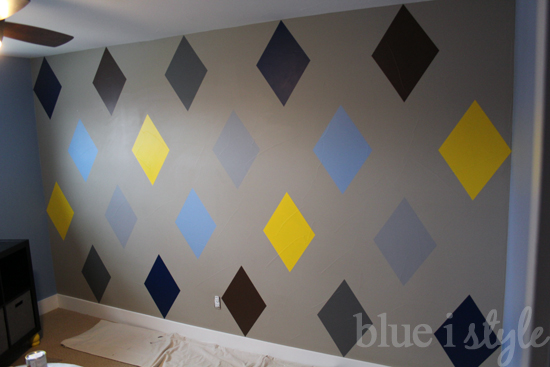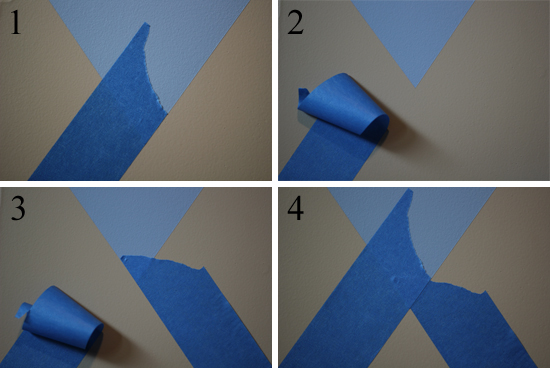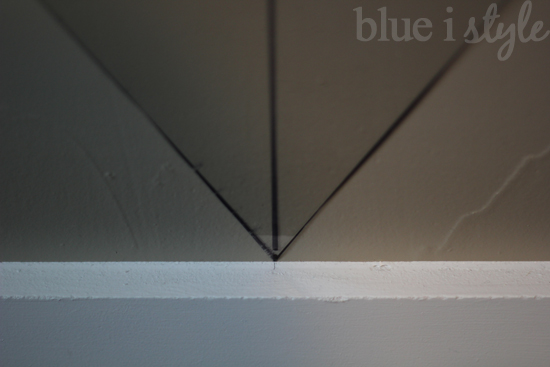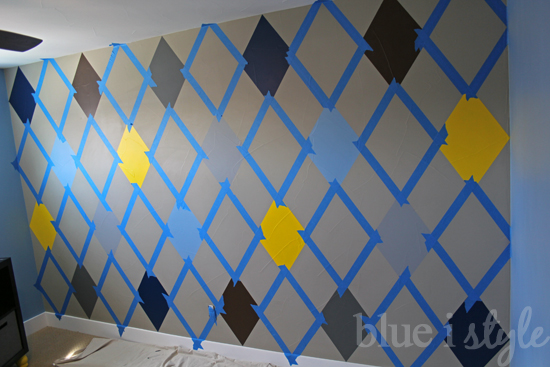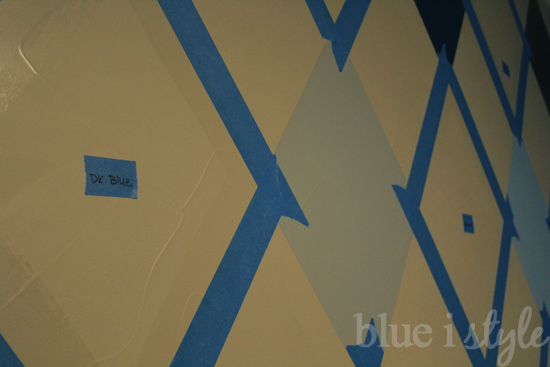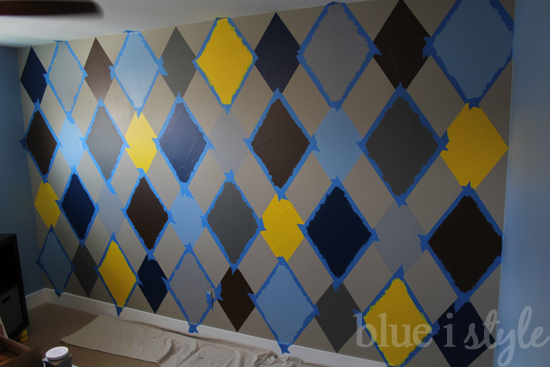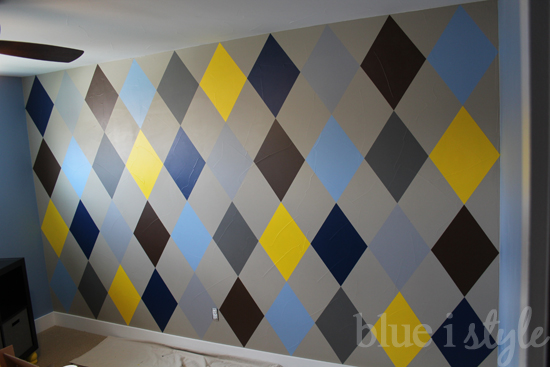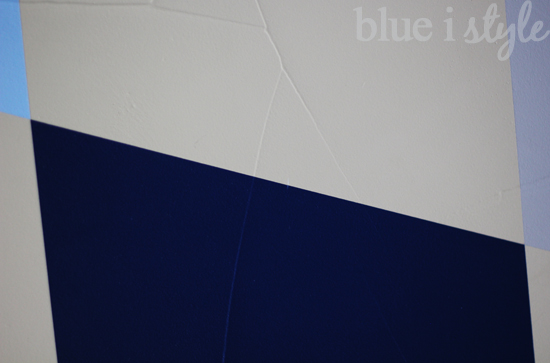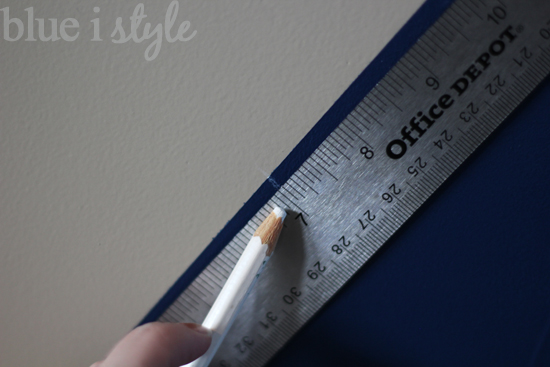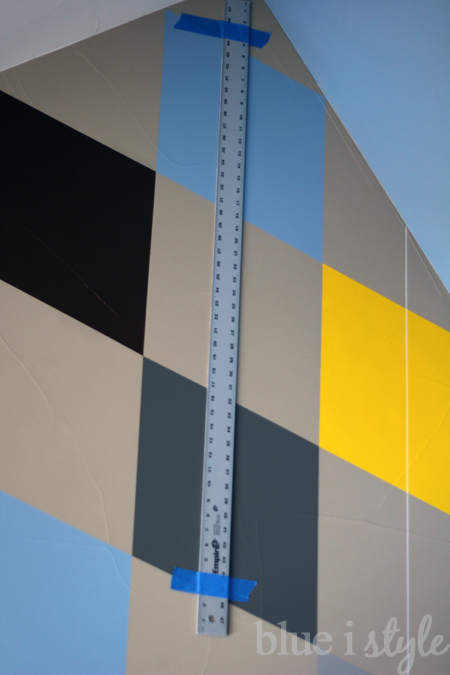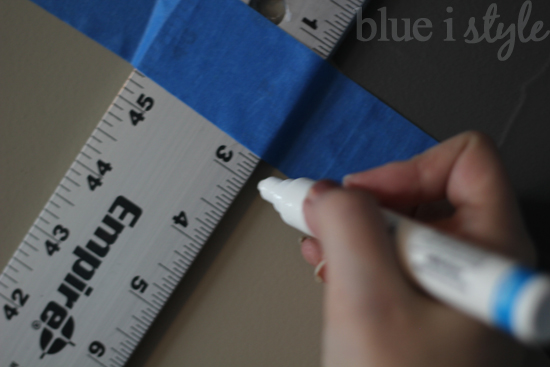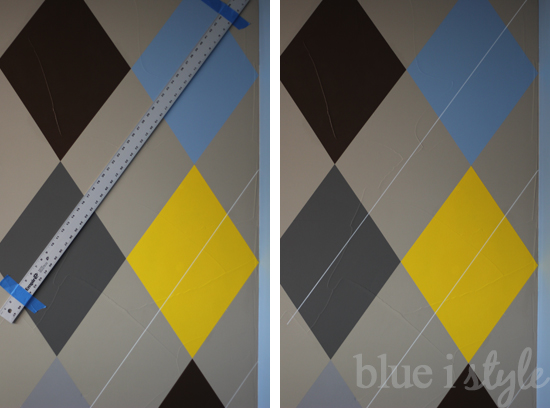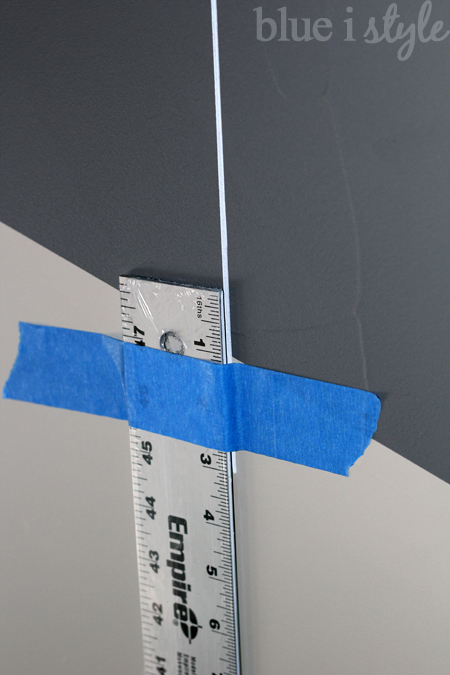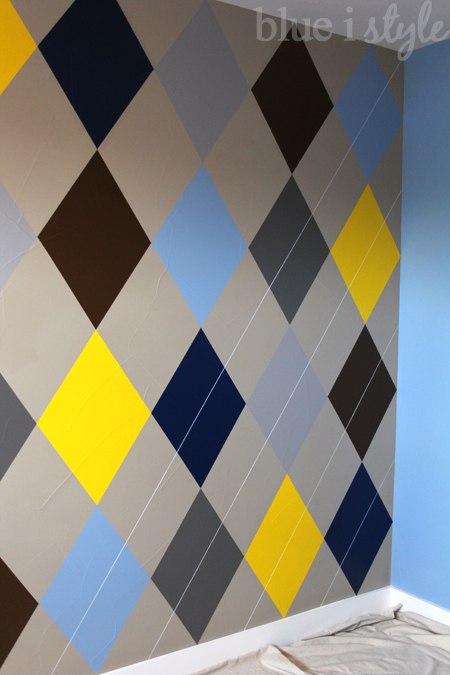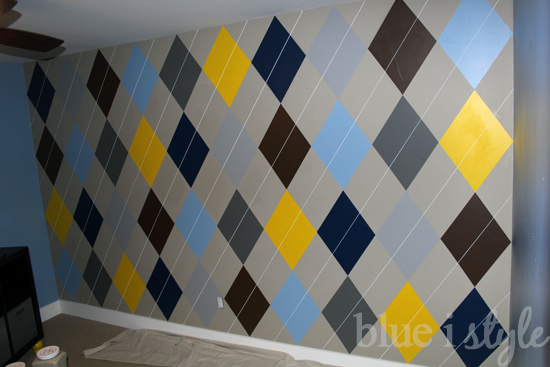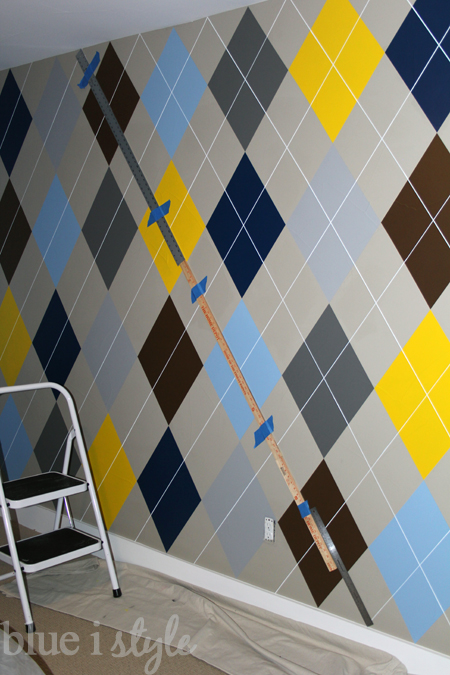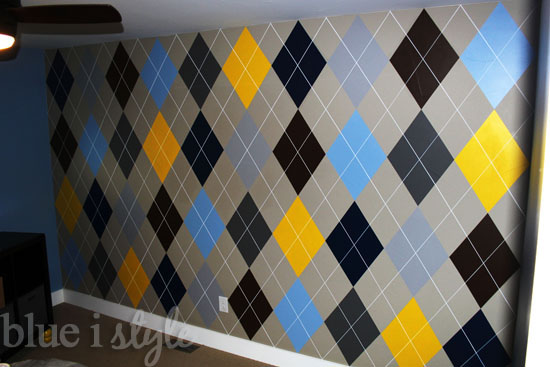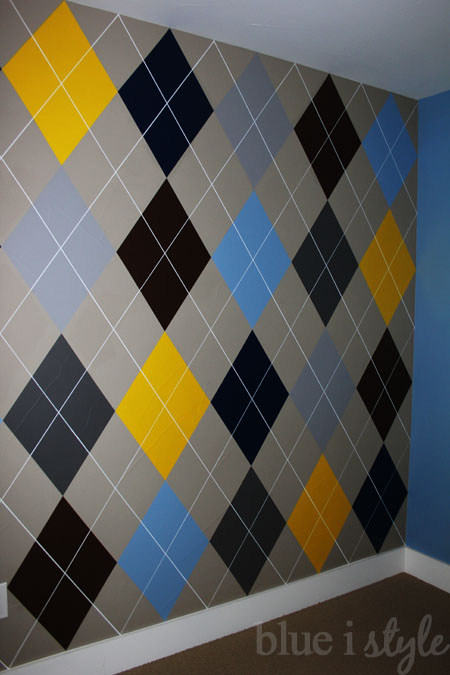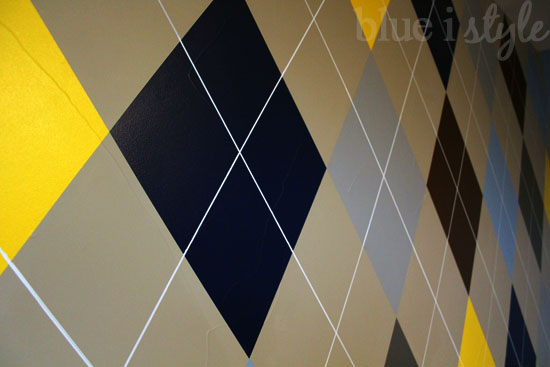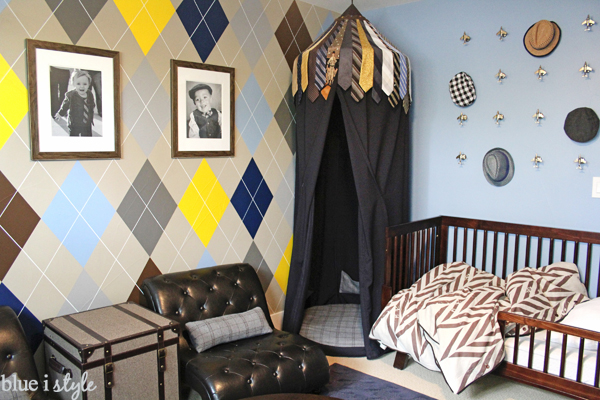Last week I revealed my completed argyle wall, and you guys sure showed it a lot of love! Thank you so much for all of the sweet compliments! As promised, I am going to give you a full, step-by-step tutorial for how I painted the wall. I will warn you that this is going to be a long post, because, not surprisingly, painting argyle is a many step process. But here’s the thing, if you have some patience and desire, it is a TOTALLY DOABLE project!
Before embarking on my argyle wall adventure I read several other tutorials online, and they all involved crazy amounts of math and seemed overly complicated and hard to replicate. My goals were to simplify the process as much as possible, to eliminate the geometry headaches, and to minimize the amount of measuring and taping I had to do. I ended up using a method total different from any other I’ve seen online, but one that worked extremely well and produced exactly the results I was after!
{If you are just interested in basic painting tips, this note is for you!} Of course, I realize that not many people are actually going to want an argyle wall in their own home, and many of you are simply interested in how I achieved such crisp, clean lines. If that’s you, hop over here to read my best tips and tricks for painting any space, big or small. Even if you are just interested in getting a clean line where your paint meets the baseboards or ceiling, I have tips to help you out! And if stripes are your game, please also hop over here to my Ombre Striped Wall Tutorial for some additional tips on measuring and taping stripes!
Ok, now back to how to paint argyle…
Let’s start with the supply list:
- Measuring tape
- Duralar or similar heavy duty clear plastic for creating templates
- Level
- Painter’s tape
- Behr Faux Glaze
- Mini paint rollers and trays (one per paint color)
- Latex Paint
- Baby wet wipes
- Gallon-sized Ziploc bags
- Sharpie Water-Based Paint Pen (medium tip)
- White chalk
- 48″ straight edge, and at least two other yard sticks or rulers
Alright, buckle up! Here comes a detailed, step-by-step tutorial on how to paint an argyle wall…
Warning: this is the step that requires some math, but just some basic division. And if you follow me through this step, I can show you a simple way to paint an argyle wall without any further need for calculations.
Before you can calculate the measurements for your diamonds, you’ll need to decide the look and scale you are after. I did some Google image searching and learned that I am not the only one crazy enough to paint an argyle wall. Looking at photos of walls that others have painted really helped me because I could visualize what the scale of the diamonds would look like if I painted three rows of diamonds versus if I painted four or even five rows of diamonds. I determined that four rows would give me the look I was after {not too big, not too small}. Once I made this decision, it was time to measure and do some math.
For this step, it’s helpful to have an adorable assistant.
I measured the wall and noted the exact dimensions {I recommend measuring a couple of times to be sure, since these measurements are going to determine everything moving forward}.
Since I decided to paint four rows of diamonds, I divided the total wall height by four, and determined that each row (and therefore each diamond) would be 22.625 (22 5/8) inches tall.
Next I needed to determine the width of each diamond. In order to achieve the look of argyle, the diamonds need to be taller than they are wide, so I automatically knew that the diamonds would need to be less than 22 5/8″ wide. As a baseline, I calculated that if I made the diamonds 22 5/8″ wide, about 7 diamonds would fit across the wall, which told me that, because I wanted narrower diamonds, I would need more than 7 columns. I wanted to paint only full diamonds (i.e. no partial diamonds), so I simply took the width of the wall and used a trial and error process to determine a number of columns greater than 7 that would give me good overall dimensions for my diamonds. I divided the total wall width by 8, 9, 10 and 11 to determine what the diamond width would be assuming each of these numbers of columns.
158.125/8=19.765625
158.125/9=17.56944
158.125/10=15.8125 (15 13/16)
158.125/11=14.375 (14 3/8)
I then used Photoshop to draw diamonds with each of these width dimensions (using 22 5/8″ as the height), to see which would would result in a diamond with the most appropriate proportions. Of course, rather than using Photoshop, you could simply draw out the diamonds by hand.
This visual helped me to see that the diamonds would be too wide if I painted only 8 columns, but that 9, 10 or 11 columns would all produce proportions that looked appropriate for argyle. To make the process as easy as possible, I decided to go with either 10 or 11 columns since each of these result in widths that are easily measurable fractions (8ths or 16ths). Finally, since I didn’t want to tape any more diamonds than necessary, I decided to go with 10 columns rather than 11.
Ok, so if you followed all of that, then you are set, and that’s the last of the math you’ll have to do!
My calculations determined that each of my diamonds would be 22 5/8″ high by 15 13/16″ inches wide, resulting in a total of 40 diamonds to be painted on my wall.
Once you’ve determined the dimensions of your diamonds, you’ll need to select the layout of your colors. You can achieve the look of argyle with as few as two colors, but to pull together all of the colors I wanted in Beckett’s room, I selected a total of seven colors {beige, brown, light grey, yellow, dark blue, light blue, and dark grey}.
One of your colors will be your background color- the color on top of which you’ll paint all of your other diamonds, and will be the color which will be most predominate when the argyle is complete. Beckett’s room was previously our workout room, and the walls were a dark beige color. To avoid having the paint the entire wall before beginning the diamonds, I opted to use the beige as the background color for our argyle plan. If your existing wall color is not the color that you want to use as your background, then you’ll need to begin by painting the entire wall your chosen background color.
If you are using only two colors, then one color will be the background and the other will be the color of all of your diamonds. If you choose three colors, one will again be the background, and then I recommend painting the columns in alternating colors (one full column of one color, the next full column in the other color). To see what a three color argyle wall looks like, check this one out. Since I was painting six colors of diamonds, I selected a repeating color pattern for the first row, and then staggered each subsequent row as necessary to ensure that the same colors never abutted one another.
To determine the layout of the diamond colors, I used Photoshop to draw a mock-up of the wall and come up with a color pattern that I was happy with. If you aren’t familiar with Photoshop or another drawing program, you could simply sketch out the diamond layout on paper, make a couple of copies, and then use colored pencils to try out color layout options. This is what my mock-up looked like:
The final color decision you’ll have to make is the color of the angled lines that run through the center of each diamond. For my wall, I considered either white or black lines, and I quickly realized that black lines would likely not show up well on the dark colored diamonds. Additionally, the baseboards and closet door in the room I was painting are white, so adding white angled lines to the wall would help tie everything together.
In the other argyle wall tutorials I’ve read, you begin by drawing a grid on the wall – requiring you to essentially measure, level, and mark 4 horizontal stripes and 10 vertical stripes. If you’ve ever painted stripes, then you know that this is not a quick and easy process, so you’ll be happy to hear that I have a better way that will save you hours and avoid you having to erase or paint over all those grid lines! My method simply requires that you cut out three diamond templates.
I’ll pause here to say that I considered making stencils instead of templates, but decided against the stencil method for two main reasons. (1) By using a template instead of a stencil, I was able to tape half of the diamonds before putting any paint on the wall, allowing me to see that the layout of the wall was going to be correct. If you instead use a stencil, you’ll be putting paint to the wall right from the start, and if you later realize that your row of diamonds is crooked or that something isn’t coming together right, it will be too late to make adjustments. (2) Using a stencil would have made it much more difficult to achieve the crisp, precise lines that give argyle its tailored look.
Ok, so back to the templates. I first planned to buy sheets of plastic from Hobby Lobby called stencil blanks – sheets that can be used to cut your own stencils, or in my case templates. However, the largest size of stencil blank I could find was 12×18 – too small for my diamonds. Instead, I ended up going to my favorite specialty art store (Meininger Art Materials) and purchasing two 30×40 sheets of a material called Duralar at a cost of about $10/sheet. This material worked perfectly because it’s clear and thick enough to be durable, but thin enough to be easily cut. I measured and drew three diamonds using the dimensions I determined in Step 1.
Then I cut out each template, and used a Sharpie to draw a horizontal and a vertical line across the center of each diamond. These lines become important in the next step.
Once the templates are made, I was ready to tape the first set of diamonds. You’ll want to pick one corner of the wall in which to start – I started in the top left corner. I placed my first diamond in the top corner, and then used a small level to check that both lines on the template were level horizontally and vertically.
Once the diamond was level, I stuck it to the wall using two rolled up pieces of Scotch Blue Painter’s Tape, and then taped around the diamond.
With the first diamond taped, I left the template in place and added two more templates to the right. I placed the templates so that the points touched, but did not overlap, and again used my level to make sure that each diamond was lined up just right. As you can see, you won’t be able to tape around abutting diamonds, because the tape of one diamond overlaps the diamond next to it. Instead, you’ll tape every other diamond, and then after painting these diamonds you’ll go back and tape the in-between diamonds (but more on that later).
For ease of explanation, consider the templates above to be called 1, 2 and 3 from left to right. Once you’ve taped around template 3, you can remove template 1 and 2 and move them to the right side of template 3, lining them up and leveling them in order to tape your next diamond. Then continue this process, moving two templates at a time until you’ve completed the entire top row.
In theory, you could simply line the diamond templates up using the ceiling as a guide, but even in newer houses the ceiling and walls are often not 100% level. This is why it is so important to use the lines on the template and a level to ensure that the diamonds are properly aligned, and then make adjustments as necessary while taping. For example, my ceiling is a bit lower in one spot near the center of the wall, so when I lined one of the templates up with the diamonds to the left, the top point of the template curved up onto the ceiling by about an 1/8th of an inch. In this spot, I simply adjusted the tape to bring the angle of the top of the diamond in a bit so that the top point of the diamond was correctly placed right where the wall meets the ceiling.
Once I completed the top row of diamonds, I wanted to check my work before moving on the second row. I used a three foot long level to check that the bottom point of every diamond was level with all the other bottom points. This is very important, because if the top row of diamonds is not level, it will throw off each subsequent row.
After confirming the level of row 1, I was ready to start taping the second row. The photo below shows how I placed the first diamond template on the second row using the templates on the top as a guide.
The process continues row upon row using the same method.
About 2 hours later, the entire first set of diamonds was taped.
Here I am putting the first color on the wall…the true point of no return.
With these mini rollers, it only took a minute or so to paint each diamond. We ended up using two or three coats of paint on each diamond, as necessary. {Note that the yellow paint also required a yellow tinted primer.} Any time you are using latex paint, always keep some baby wet wipes on hand. If you get paint anywhere that you don’t intend, it will easily wipe away as long as you don’t allow it to dry!
A couple more hours, and the wall looked like this:
We then removed the tape and admired our work.
Since we knew it would be a day or so before we’d be ready to paint again, we placed each of our paint trays and rollers inside of a Ziploc bag to keep the paint from drying out.
I continued using this methodology to connect all of the points of the painted diamonds. Along the ceiling, baseboard, at at the corners, I used my templates again to tape the final points.
Check out those crisp, clean lines and look how those points line up just perfectly!!
I was really happy with what I had accomplished, but it wasn’t argyle yet. At this stage, what I really had was a wall of harlequin diamonds.
The second half of the diagonal lines were a little trickier than the first, because in addition to lining up all of the white pencil marks on the center of each side of the diamonds, I also had to make sure that the lines matched up perfectly with where the first set of lines met the ceiling, baseboard and corners. Because even a slight deviation along the length of the line would cause it not to match up at the other end, I decided to tape multiple straight edges together to span the entire height of the wall so that I could see – before drawing in any portion of the line – that everything would line up.
